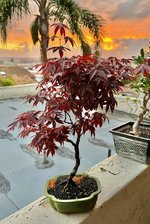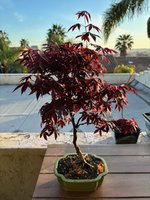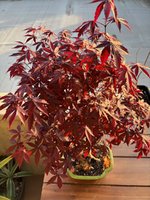zeejet
Mame
I obtained an inexpensive red maple from Brussel’s Bonsai in January and I would say I was pretty lucky to score this tree for only $50. It budded profusely and has had very vigorous growth since early March.
It’s relatively young and has a thin trunk (⅝”) that I’d like to thicken to at least 1” caliper before moving into chopping for taper development.
I’m not entirely sure what to do right now. My impression is that I should just let it grow unimpeded and only prune back slightly during winter to setup for next season. However, the density of the foliage might be depriving the inner sections of sunlight, which could lead to interior dieback. I also hear that pruning can initiate a second flush of foliar growth, which would continue to contribute to trunk thickening.
The plan next spring is to revert back to a growing container (grow box or 2-gallon pond basket) during repot to put it on a faster growth track.
What would you do in this situation?



It’s relatively young and has a thin trunk (⅝”) that I’d like to thicken to at least 1” caliper before moving into chopping for taper development.
I’m not entirely sure what to do right now. My impression is that I should just let it grow unimpeded and only prune back slightly during winter to setup for next season. However, the density of the foliage might be depriving the inner sections of sunlight, which could lead to interior dieback. I also hear that pruning can initiate a second flush of foliar growth, which would continue to contribute to trunk thickening.
The plan next spring is to revert back to a growing container (grow box or 2-gallon pond basket) during repot to put it on a faster growth track.
What would you do in this situation?



Last edited:
